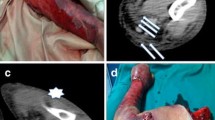Abstract
Objective
To investigate which computed tomography (CT) criteria are most useful in diagnosing necrotizing soft tissue infection (NSTI) and how CT performs with respect to the Laboratory Risk Indicator for Necrotizing Fasciitis (LRINEC) score.
Methods
Patients who underwent CT for suspected NSTI were eligible for inclusion. LRINEC score was assessed. CT scans were evaluated for subcutaneous edema, fluid along superficial fascia, fluid along deep fascia, blurring of intermuscular fat planes, fluid collection, and air in the soft tissues. Surgical findings or clinical follow-up served as reference standard.
Results
Fourteen patients with NSTI and 34 patients with non-NSTI were included. LRINEC score was significantly higher in patients with NSTI (median of 7.5 vs. 6, p = 0.039). Fluid along the deep fascia was significantly more frequently present in patients with NSTI (46.2% vs. 5.9%, p = 0.001). In multiple logistic regression analysis, presence of fluid along the deep fascia was significantly associated with NSTI (odds ratio [OR] = 10.28, 95% CI: 1.57 to 67.18, p = 0.015), whereas the LRINEC score was not significantly associated with NSTI (OR = 1.27, 95% CI: 0.92 to 1.74, p = 0.146). Using presence of fluid along the deep fascia as diagnostic criterion for NSTI, sensitivity was 46.2% (95% CI, 23.2 to 70.9%) and specificity was 94.1% (95% CI, 80.9 to 98.4%).
Conclusion
Fluid along the deep fascia was the only CT criterion which was significantly associated with NSTI and appeared more useful than the LRINEC score. In the right clinical setting, presence of this CT finding is highly suggestive for NSTI. Its absence, however, does not rule out NSTI.
Key Points
• The presence of fluid along the deep fascia at CT is highly suggestive for NSTI in suspected patients. Its absence, however, does not rule out NSTI.
`• The use of fluid along the deep fascia as a criterion appears to be more useful than the LRINEC score in diagnosing NSTI.



Similar content being viewed by others
Abbreviations
- CT:
-
Computed tomography
- LRINEC:
-
Laboratory Risk Indicator for Necrotizing Fasciitis
- NSTI:
-
Necrotizing soft tissue infection
References
Stevens DL, Bryant AE (2017) Necrotizing soft-tissue infections. N Engl J Med 377:2253–2265. https://doi.org/10.1056/NEJMra1600673
Henry SM, Davis KA, Morrison JJ, Scalea TM (2018) Can necrotizing soft tissue infection be reliably diagnosed in the emergency department? Trauma Surg Acute Care Open 3:e000157. https://doi.org/10.1136/tsaco-2017-000157
Howell EC, Keeley JA, Kaji AH et al (2019) Chance to cut: defining a negative exploration rate in patients with suspected necrotizing soft tissue infection. Trauma Surg Acute Care Open 4:e000264. https://doi.org/10.1136/tsaco-2018-000264
Keung EZ, Liu X, Nuzhad A, Adams C, Ashley SW, Askari R (2013) Immunocompromised status in patients with necrotizing soft-tissue infection. JAMA Surg 148:419–426. https://doi.org/10.1001/jamasurg.2013.173
Wong CH, Khin LW, Heng KS, Tan KC, Low CO (2004) The LRINEC (Laboratory Risk Indicator for Necrotizing Fasciitis) score: a tool for distinguishing necrotizing fasciitis from other soft tissue infections. Crit Care Med 32:1535–1541. https://doi.org/10.1097/01.ccm.0000129486.35458.7d
Fernando SM, Tran A, Cheng W et al (2019) Necrotizing soft tissue infection: diagnostic accuracy of physical examination, imaging, and LRINEC Score: a systematic review and meta-analysis. Ann Surg 269:58–65. https://doi.org/10.1097/SLA.0000000000002774
Fayad LM, Carrino JA, Fishman EK (2007) Musculoskeletal infection: role of CT in the emergency department. Radiographics 27:1723–1736. https://doi.org/10.1148/rg.276075033
Martinez M, Peponis T, Hage A et al (2018) The role of computed tomography in the diagnosis of necrotizing soft tissue infections. World J Surg 42:82–87. https://doi.org/10.1007/s00268-017-4145-x
McGillicuddy EA, Lischuk AW, Schuster KM et al (2011) Development of a computed tomography-based scoring system for necrotizing soft-tissue infections. J Trauma 70:894–899. https://doi.org/10.1097/TA.0b013e3182134a76
Zacharias N, Velmahos GC, Salama A et al (2010) Diagnosis of necrotizing soft tissue infections by computed tomography. Arch Surg 145:452–455. https://doi.org/10.1001/archsurg.2010.50
Bossuyt PM, Reitsma JB, Bruns DE, et al; STARD Group (2015) STARD 2015: an updated list of essential items for reporting diagnostic accuracy studies. Radiology 277:826–832. https://doi.org/10.1148/radiol.2015151516
Kim KT, Kim YJ, Lee JW et al (2011) Can necrotizing infectious fasciitis be differentiated from nonnecrotizing infectious fasciitis with MR imaging? Radiology 259:816–824. https://doi.org/10.1148/radiol.11101164
Ranganathan P, Pramesh CS, Aggarwal R (2017) Common pitfalls in statistical analysis: Logistic regression. Perspect Clin Res 8:148–151. https://doi.org/10.4103/picr.PICR_87_17
Yoon MA, Chung HW, Yeo Y et al (2019) Distinguishing necrotizing from non-necrotizing fasciitis: a new predictive scoring integrating MRI in the LRINEC score. Eur Radiol 29:3414–3423. https://doi.org/10.1007/s00330-019-06103-0
Hasham S, Matteucci P, Stanley PR, Hart NB (2005) Necrotising fasciitis. BMJ 330:830–833. https://doi.org/10.1136/bmj.330.7495.830
Sarani B, Strong M, Pascual J, Schwab CW (2009) Necrotizing fasciitis: current concepts and review of the literature. J Am Coll Surg 208:279–288. https://doi.org/10.1016/j.jamcollsurg.2008.10.032
Funding
The authors state that this work has not received any funding.
Author information
Authors and Affiliations
Corresponding author
Ethics declarations
Guarantor
The scientific guarantor of this publication is RM Kwee.
Conflict of interest
The authors of this manuscript declare no relationships with any companies whose products or services may be related to the subject matter of the article.
Statistics and biometry
One of the authors has significant statistical expertise.
Informed consent
Written informed consent was waived by the Institutional Review Board.
Ethical approval
Institutional Review Board approval was obtained.
Methodology
• Retrospective
• Observational
• Performed at one institution
Additional information
Publisher’s note
Springer Nature remains neutral with regard to jurisdictional claims in published maps and institutional affiliations.
Rights and permissions
About this article
Cite this article
Bruls, R.J.M., Kwee, R.M. CT in necrotizing soft tissue infection: diagnostic criteria and comparison with LRINEC score. Eur Radiol 31, 8536–8541 (2021). https://doi.org/10.1007/s00330-021-08005-6
Received:
Revised:
Accepted:
Published:
Issue Date:
DOI: https://doi.org/10.1007/s00330-021-08005-6




